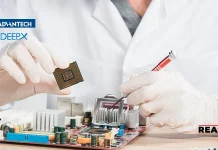Electronic skin patches have made remarkable progress in the field of healthcare. These wearable electronic devices feature adhesive pads designed to be worn directly on the skin, enabling convenient and non-invasive monitoring of vital signs and biomarkers. In the field of cardiac monitoring, patients can wear a patch that records their electrocardiogram continuously for multiple days with the Holter monitor or a Mobile Cardiac Telemetry device. For diabetic patients, glucose monitoring and delivery have become almost entirely automated with the continuous glucose monitor (CGM) and patch pump.
However, outside their success in healthcare, electronic skin patches have yet to fully realize their potential to improve daily life, including athletic capabilities, personal well-being, and worker safety. Their direct skin contact design makes them ideal for detecting analytes in sweat, as well as other biometric markers such as temperature. In the report, IDTechEx investigates the technologies and applications of electronic skin patches and forecasts that the total market will grow from US$14 billion in 2023 to US$27 billion by 2033. This article delves into the exciting potential of electronic skin patches in shaping everyday life.
Athletes have long looked towards wearable technologies to augment and improve performance in sports. Beyond heart rate monitoring chest straps and smartwatches, endurance athletes are exploring the use of CGMs. By continuously monitoring glucose levels, athletes can better manage their energy and optimize their performance and training to gain a competitive edge.
For contact sports, such as American football, electronic skin patches with inertia measurement units can be used to assess the risk of traumatic brain injury, an issue that has gained increasing attention in recent years. However, competition from other form factors, for instance, smart mouthguards and optical motion capture systems that don’t encumber the athlete, limit the adoption of electronic skin patches for contact sports. As electronic skin patches continue to evolve in the sports industry, they must identify their unique value proposition where their form factor outperforms other options, such as smartwatches.
SOURCE: PR Newswire




